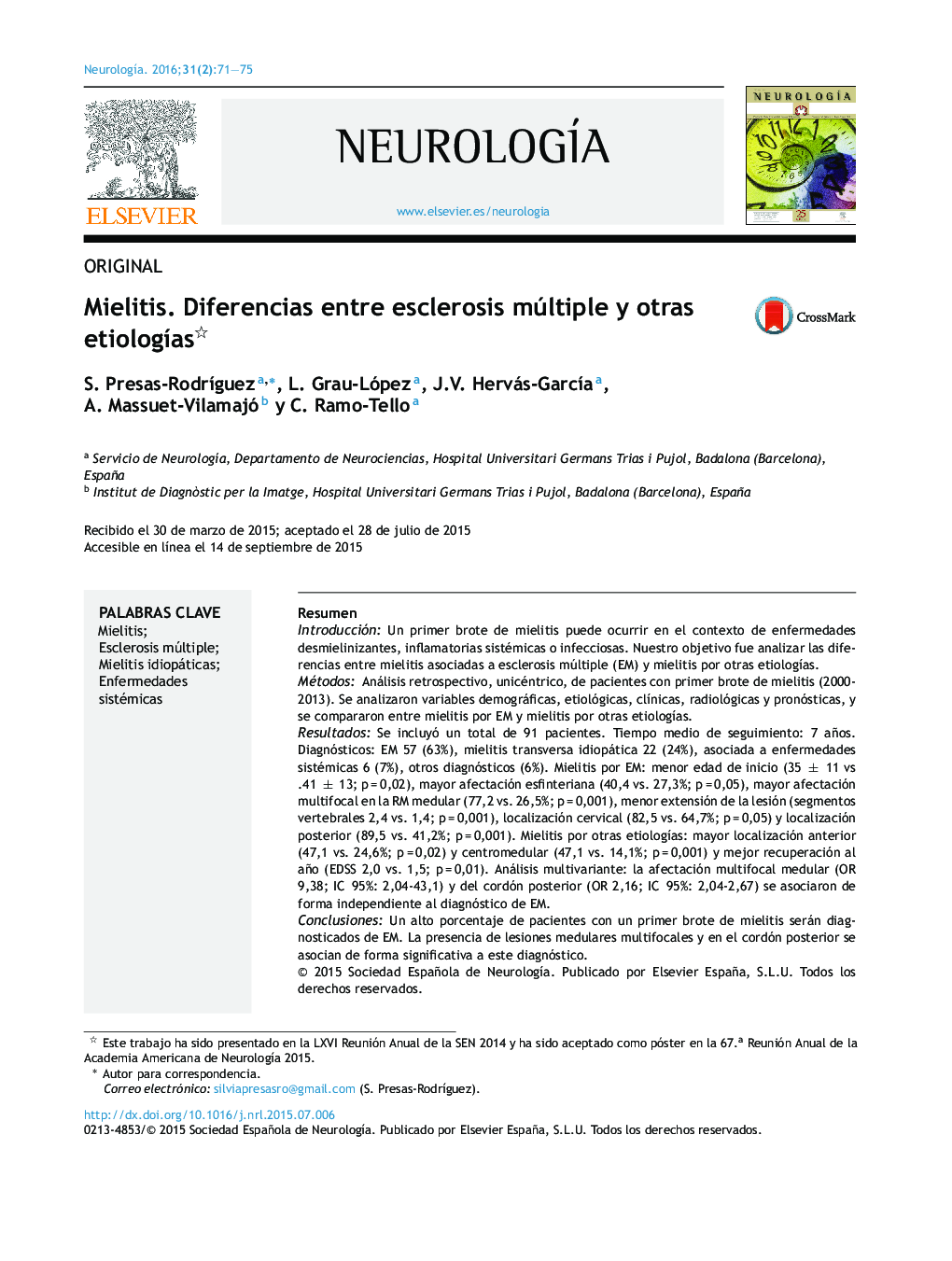| Article ID | Journal | Published Year | Pages | File Type |
|---|---|---|---|---|
| 3075668 | Neurología | 2016 | 5 Pages |
ResumenIntroducciónUn primer brote de mielitis puede ocurrir en el contexto de enfermedades desmielinizantes, inflamatorias sistémicas o infecciosas. Nuestro objetivo fue analizar las diferencias entre mielitis asociadas a esclerosis múltiple (EM) y mielitis por otras etiologías.MétodosAnálisis retrospectivo, unicéntrico, de pacientes con primer brote de mielitis (2000-2013). Se analizaron variables demográficas, etiológicas, clínicas, radiológicas y pronósticas, y se compararon entre mielitis por EM y mielitis por otras etiologías.ResultadosSe incluyó un total de 91 pacientes. Tiempo medio de seguimiento: 7 años. Diagnósticos: EM 57 (63%), mielitis transversa idiopática 22 (24%), asociada a enfermedades sistémicas 6 (7%), otros diagnósticos (6%). Mielitis por EM: menor edad de inicio (35 ± 11 vs .41 ± 13; p = 0,02), mayor afectación esfinteriana (40,4 vs. 27,3%; p = 0,05), mayor afectación multifocal en la RM medular (77,2 vs. 26,5%; p = 0,001), menor extensión de la lesión (segmentos vertebrales 2,4 vs. 1,4; p = 0,001), localización cervical (82,5 vs. 64,7%; p = 0,05) y localización posterior (89,5 vs. 41,2%; p = 0,001). Mielitis por otras etiologías: mayor localización anterior (47,1 vs. 24,6%; p = 0,02) y centromedular (47,1 vs. 14,1%; p = 0,001) y mejor recuperación al año (EDSS 2,0 vs. 1,5; p = 0,01). Análisis multivariante: la afectación multifocal medular (OR 9,38; IC 95%: 2,04-43,1) y del cordón posterior (OR 2,16; IC 95%: 2,04-2,67) se asociaron de forma independiente al diagnóstico de EM.ConclusionesUn alto porcentaje de pacientes con un primer brote de mielitis serán diagnosticados de EM. La presencia de lesiones medulares multifocales y en el cordón posterior se asocian de forma significativa a este diagnóstico.
BackgroundMyelitis can appear as an initial symptom in the context of demyelinating diseases, systemic inflammatory diseases, and infectious diseases. We aim to analyse the differences between myelitis associated with multiple sclerosis (MS) and myelitis resulting from other aetiologies.MethodsSingle-centre, retrospective analysis of patients with initial myelitis (2000-2013). Demographic, aetiological, clinical, radiological and prognostic variables were analysed and compared between patients with myelitis from MS and those with myelitis due to other aetiologies.ResultsWe included 91 patients; mean follow-up was 7 years. Diagnoses were as follows: MS 57 (63%), idiopathic transverse myelitis 22 (24%), associated systemic diseases 6 (7%), and other diagnoses (6%). Myelitis due to MS was associated with younger age of onset (35 ± 11 vs. 41 ± 13; P = .02), more pronounced sphincter involvement (40.4 vs. 27.3%; P=.05), greater multifocal involvement in spinal MRI (77.2 vs. 26.5%; P=.001), shorter lesion extension (2.4 vs. 1.4 vertebral segments; P=.001), cervical location (82.5 vs. 64.7%; P=.05) and posterior location (89.5 vs. 41.2%; P=.001). Myelitis due to other aetiologies more frequently showed anterior location (47.1 vs. 24.6%; P=.02), and central cord involvement (47.1 vs. 14.1%; P=.001), with better recovery at one year of follow up (EDSS 2.0 vs. 1.5; P=.01). Multivariate analysis showed that multifocal spinal cord involvement (OR 9.38, 95% CI: 2.04-43.1) and posterior cord involvement (OR 2.16, 95% CI: 2.04-2.67) were independently associated with the diagnosis of MS.ConclusionsA high percentage of patients with an initial myelitis event will be diagnosed with MS. The presence of multifocal and posterior spinal cord lesions was significantly associated with the diagnosis of MS.
